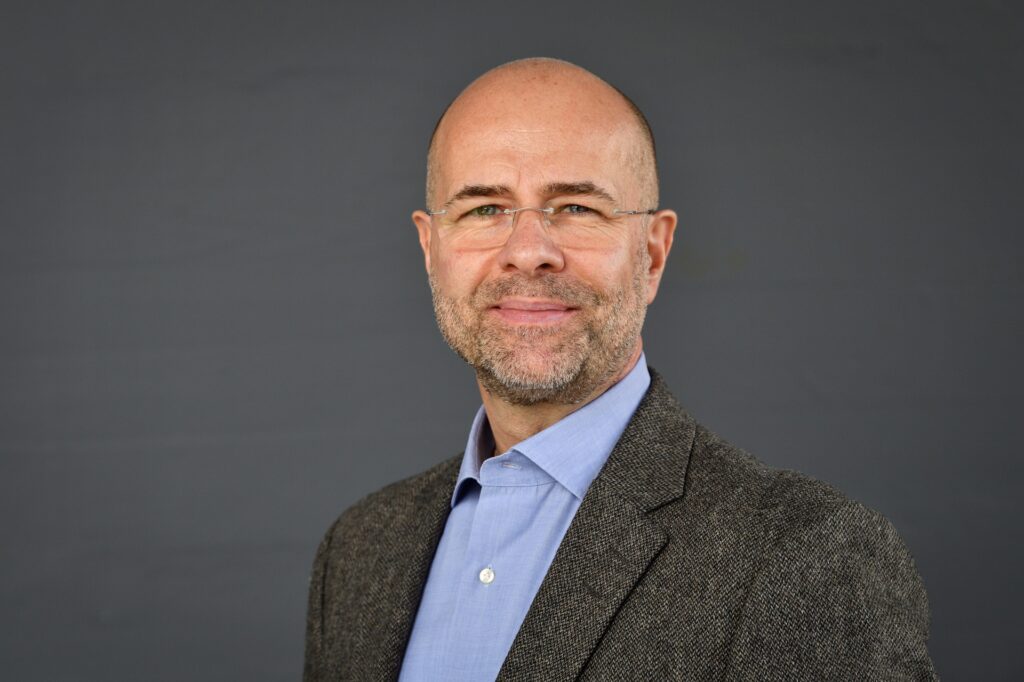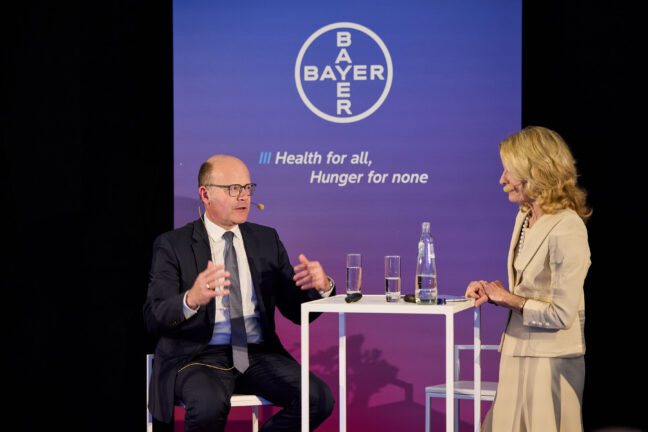Europe has the science, the workforce, and the global footprint to lead in pharmaceutical innovation. However, it still treats the pharmaceutical sector as a budget line, not a strategic asset.
“If there’s a problem in the car industry, all my colleagues start running. If there’s a problem in the health sector, people say it’s too expensive,” said MEP Oliver Schenk at a recent Bayer event on European life sciences competitiveness.
Germany is rightly proud of its car industry. With around 800,000 workers and a global export reputation, it is treated as a cornerstone of national identity and economic strategy. But here is the paradox: over five million Germans work in the health sector, yet it is still seen as a budgetary burden.
This disconnect sits at the heart of MEP Oliver Schenk’s call for a strategic reset in how Europe approaches pharmaceutical innovation. As ITRE (Committee on Industry, Research and Energy) rapporteur on the EU’s Critical Medicines Act, he is advocating for something that should be obvious but remains politically neglected: Europe must treat its pharmaceutical sector not as a cost to contain, but as infrastructure to invest in.
You might be interested
The cost mindset is outdated, and dangerous
Pharmaceutical research isn’t just an economic engine. It’s one of the few sectors that tangibly expands human life. “Every year, we gain two to three months of life expectancy,” Schenk noted.
“Every child born today has a real chance to live to 100.” But instead of recognising this progress as a societal achievement, too often, policy focuses on what healthcare costs, not what it delivers.
Many successful U.S. pharma firms are built on European science (…) But they couldn’t do their businesses in Europe. – MEP Oliver Schenk
This budget-first thinking is undermining Europe’s competitiveness. While the EU has world-class scientists and academic institutions, it struggles to translate research into real therapies. Bureaucracy, fragmented pricing rules, and underpowered investment ecosystems are pushing breakthrough ideas across the Atlantic or to China.
Schenk put it plainly: “Many successful U.S. pharma firms are built on European science (…) But they couldn’t build their businesses in Europe.” He added: “Just last week, I spoke with pharmaceutical companies in the U.S. who told me their ideas came from Europe, but the environment here was too fragmented and too slow to build on them,” MEP Oliver Schenk said.
Faster science, slower systems
Christine Roth, Bayer’s EVP of Global Product Strategy and Commercialisation, emphasised the urgent need for regulatory alignment. “With all the energy we put into increasing our pace, that pace is often negated by regulatory reviews.”
In Europe today, on average, it can take an additional 200 days for an approval to come compared to a country like the U.S. And then that wait is further extended for patients in most European countries when you add on the delays in access and reimbursement. So an innovation-friendly ecosystem policy would address those two things.”
Matthias Berninger, Bayer’s Global Head of Public Affairs, Science & Sustainability, reinforced this point with a broader geopolitical lens. He warned that Europe benefits from lower drug prices while relying heavily on U.S.-driven innovation, a model increasingly questioned by American policymakers. “President Trump challenged that imbalance,” he told EU Perspectives. “And while his approach may have been crude, he wasn’t wrong.”
As the U.S. turns inward and China grows more strategic, Europe has a rare opportunity to lead. But this will require consistent, innovation-friendly policies.
Science isn’t the bottleneck
Christian Rommel, Bayer’s EVP and Global Head of Research & Development, was blunt: the bottleneck is no longer science. “The science is there,” he said. “What we are lacking is an ecosystem in Europe that is predictable and risk-tolerant.” Despite having cutting-edge capabilities, from gene and cell therapy to digital biomarkers, Europe still struggles to translate breakthroughs into timely patient access.

Rommel and Berninger both stressed that without systemic change, Europe risks becoming merely a consumer of global innovation, not a driver. “This is a question of sovereignty,” Berninger said. “If Europe wants to shape the future of medicine, it needs to build the foundation now.”
Key legislation: a critical opportunity for alignment
Berninger was also candid about the tone and tools of EU policy. In discussing the revision of the pharmaceutical legislation, he warned that while well-intentioned, many of the proposed ‘carrots’ end up feeling more like ‘sticks’ to the industry. “We often see incentives turn into obligations,” he said, referring to policy frameworks that start out as supportive but end up increasing compliance burdens or uncertainty.
He contrasted this with China’s approach, saying that while the EU hesitates with half-measures, “there is no shortage of carrots in China.” The Chinese government, he noted, offers consistent incentives, long-term vision, and policy clarity, elements that Europe too often lacks. Without real carrots, Europe risks losing out in the global competition for innovation.
For Europe to truly boost its attractiveness, Berninger argued, it needs to send clear, consistent signals and reward risk-taking with stable policy frameworks. Schenk summed it up bluntly: “Innovation requires incentives. The EU can’t lead in pharmaceutical development if it weakens the foundations that make it economically viable.”
General Pharma Legislation and Critical Medicines Act
Berninger also weighed in on the EU’s most consequential pharmaceutical policy files, the revision of the general pharmaceutical legislation and the Critical Medicines Act. He cautioned that while both offer opportunities to strengthen Europe’s resilience and innovation capacity, they risk sending mixed signals.
On the Critical Medicines Act, he welcomed the ambition to boost Europe’s manufacturing autonomy, particularly for antibiotics and off-patent drugs. But he stressed the importance of recognising those companies that never left Europe. “We’ve kept antibiotic production in Italy,” he said. “Policy should not just reward those you want to attract, but also support those who stayed and delivered during the pandemic.”
True innovation is expensive, risky, and requires long-term reward. – Matthias Berninger, Bayer’s Global Head of Public Affairs, Science & Sustainability
Regarding the pharmaceutical legislation reform, Berninger voiced concern that the balance between access and incentives was tipping too far toward short-term savings. “During COVID, the EU defended patents as essential for innovation. That stance must continue,” he said. He emphasised that reducing regulatory data protection and patent duration, while already facing lower prices in Europe, would compound the economic disincentive to invest.
He also urged lawmakers to move away from one-size-fits-all approaches: “We need policies that encourage faster access, yes – but also acknowledge that true innovation is expensive, risky, and requires long-term reward.”
A delicate balance on intellectual property and access
One of the more politically sensitive areas in the EU’s pharmaceutical legislation revision is intellectual property. Some countries, especially those with limited healthcare budgets, want shorter patent protections to enable faster generic access. Others argue that without long-term intellectual property (IP) certainty, no one will invest in the kind of risky research and development (R&D) that produces first-in-class medicines.
Policy should support those who stayed and delivered during the pandemic. – Matthias Berninger, Bayer’s Global Head of Public Affairs, Science & Sustainability
MEP Schenk doesn’t pretend there’s an easy answer. But he does insist on realism: innovation requires incentives. The EU can’t lead in pharmaceutical development if it weakens the foundations that make it economically viable.
Berninger added that policy debates often overlook the high attrition rate in R&D. Bayer invests €3.5 billion annually in pharmaceutical research, much of which never reaches patients due to clinical trial failures. Undermining patent length, he argued, is effectively the same as slashing prices, and could deter future investment.
Europe must act like pharma matters
What Schenk, Roth, Rommel, and Berninger all make clear is that Europe has the scientific talent and the technological capability to lead in 21st-century medicine. What it lacks is the policy mindset to match.
Europe is at a crossroads. It can build an innovation-friendly ecosystem that supports R&D, accelerates approvals, and ensures equitable access across its member states. Or it can continue importing innovation from faster-moving regions.
To lead, Europe must act like pharma matters. Not just in strategy papers, but in regulation, investment, and political will. Like energy or transport, health innovation is critical infrastructure. The question is whether Europe will recognise it in time.





